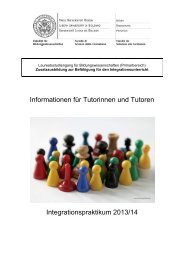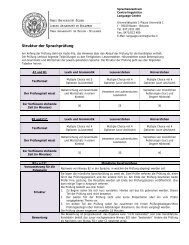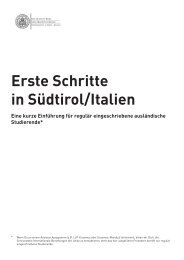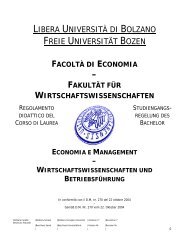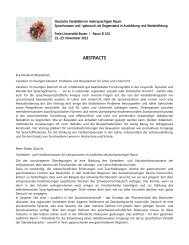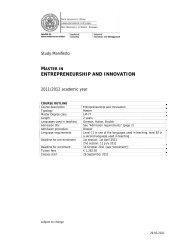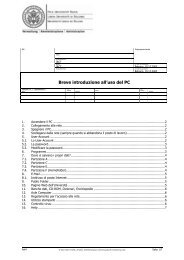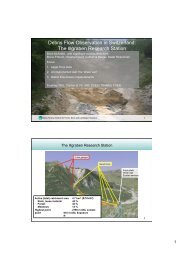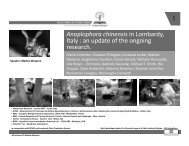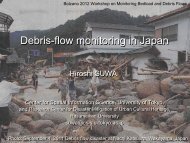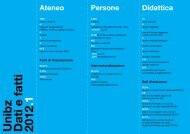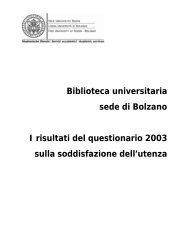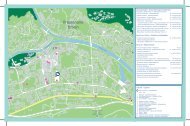You also want an ePaper? Increase the reach of your titles
YUMPU automatically turns print PDFs into web optimized ePapers that Google loves.
16<br />
fornire nuovi contenuti pubblicitari e<br />
promozionali (sms de<strong>di</strong>cati o file offerti<br />
al download gratuito, per esempio), sia<br />
per mappare gli spostamenti e l’attività<br />
dei consumatori sul territorio citta<strong>di</strong>no.<br />
Il sogno (l’incubo?) è quello <strong>di</strong> un<br />
<strong>di</strong>spositivo pubblicitario che ci riconosca<br />
quando gli passiamo davanti, ci<br />
interpelli per nome e ci invii sul cellulare<br />
l’ultima offerta commerciale che<br />
(presumibilmente) ci interessa, insieme<br />
all’in<strong>di</strong>rizzo del più vicino riven<strong>di</strong>tore:<br />
il matrimonio perfetto tra la logica del<br />
controllo e quella del consumo.<br />
the me<strong>di</strong>atisation of the<br />
cit y: Between contRol<br />
and consumption — We have<br />
learned from the abundant literature<br />
on modernity, from the outspoken<br />
testimonies of Baudelaire and Poe,<br />
of Simmel and Benjamin, to the<br />
historiographic reconstructions of<br />
Schivelbusch and Kern that sensory<br />
and communicative hyperstimulation<br />
is a typical and constant feature of<br />
the modern city. Overturning the<br />
environmental and sensory metaphors<br />
of McLuhan about the me<strong>di</strong>a as a<br />
global village, we could say that the<br />
city today is a glocal me<strong>di</strong>um. That<br />
is, it is an environment that brings<br />
together a wide and <strong>di</strong>splaced complex<br />
of subjects (in<strong>di</strong>viduals, communities<br />
and institutions) due to technological<br />
infrastructures, professional cultures<br />
and the plurality of languages that<br />
break down into a network of<br />
communicative flows.<br />
In this web of pronouncements,<br />
a particular communicative act joins<br />
in, namely, outdoor advertising.<br />
That is, that set of instruments and<br />
communicative publicity practices<br />
that try to intercept consumers,<br />
when they are outside their own<br />
domestic environment, from the more<br />
tra<strong>di</strong>tional commercial art (posters,<br />
luminous signs) to dynamic publicity<br />
(decorated means of public transport),<br />
from sponsored urban furniture (bus<br />
shelters, telephone cabins) to the most<br />
recent electronic instruments (<strong>di</strong>gital<br />
screens, video wall, <strong>di</strong>splay), to what<br />
has been defined as ambient advertising<br />
(transforming the very structural<br />
elements of the urban environment<br />
such as road bridges and frontages of<br />
buil<strong>di</strong>ngs).<br />
If it is true, at least within the<br />
tra<strong>di</strong>tion of western cultural industry,<br />
that publicity is established, historically<br />
and linguistically, as a type of parasitic<br />
<strong>di</strong>scussion that relies on the <strong>di</strong>scussions<br />
developed by the me<strong>di</strong>a, suspen<strong>di</strong>ng<br />
them, as in the case of publicity in the<br />
daily newspaper, the printed pages<br />
of magazines or perio<strong>di</strong>cals and of<br />
the advertising spots among the tv<br />
programmes, we could say that the<br />
suspended <strong>di</strong>scussion in this case is the<br />
city itself. Even from this point of view,<br />
the city is proving to be a me<strong>di</strong>um,<br />
and it is in its narrow spaces that<br />
advertising is fin<strong>di</strong>ng its own space.<br />
Now the transformation of<br />
outdoor advertising and the instruments<br />
of control linked to its marketing<br />
are an interesting in<strong>di</strong>cator of the<br />
transformation of the city as a me<strong>di</strong>um.<br />
In this way, a first structural rea<strong>di</strong>ng<br />
of urban textuality corresponds to a<br />
conception of external publicity as<br />
a form of protection of the territory<br />
able to split up its public only on such<br />
a territorial basis. It is an extremely<br />
generalist me<strong>di</strong>um therefore that<br />
makes capillary action its main<br />
weapon. We are still fully in a modern<br />
experience, even if refined by the<br />
instruments of informatic geo-planning<br />
that allow an internal charting of<br />
the entire availability of advertising<br />
establishments and selling <strong>di</strong>stribution<br />
chains.<br />
But when a second para<strong>di</strong>gm<br />
asserts itself, linking the city to a<br />
complex of communication flows able<br />
to intercept population streams moving<br />
in the city during the day, it is here that<br />
the city articulates its own complex<br />
textuality in the form of a programme<br />
with its own temporal logic that needs<br />
to monitor urban movements on the<br />
basis of which the public <strong>di</strong>vides into<br />
segments. It is no coincidence that<br />
the control instrumentation used<br />
by publicity marketing is similar to<br />
that used in television and that the<br />
Au<strong>di</strong>poster of the city corresponds<br />
to Au<strong>di</strong>tel’s small screen. It is an<br />
instrument able to supply, on the basis<br />
of samples and due to a gps system, a<br />
dynamic charting of times of exposure<br />
to in<strong>di</strong>vidual publicity installations<br />
<strong>di</strong>vi<strong>di</strong>ng up the urban population/<br />
au<strong>di</strong>ence on the basis of age and gender<br />
and attributing a quantitative value to<br />
them.<br />
Today we are witnessing the<br />
progressive assertion of a third<br />
para<strong>di</strong>gm based no longer only on a<br />
sense of vision but on the attempt,<br />
pointed out by marketing in the forms<br />
of a self-fulfilling prophecy, of involving<br />
the passer-by in a true and real multisensory,<br />
memorable and performative<br />
experience. From the point of view of<br />
the metaphors of the me<strong>di</strong>a, the most<br />
adequate image is that of multi-me<strong>di</strong>a<br />
hypertext open in more <strong>di</strong>rections able<br />
to offer a plurality of occasions of<br />
symbolic interactions.<br />
This new form of urban hyperstimulation,<br />
made necessary by the<br />
resistance opposed by the blasé of<br />
Simmel’s memory, as well as pushing<br />
in the <strong>di</strong>rection of ambient advertising,<br />
implies a new sensory device<br />
characteristic of the metropolitan<br />
nomad; the connectivity understood<br />
as the technological and social<br />
opportunity of being always on, always<br />
connected, always in the network.<br />
The chance of intercepting mobile<br />
devices, (mobile phones, laptops,<br />
personal organisers, mp3 players etc.),<br />
potentially always connected via umts,<br />
dvbh, Wi-Fi or Bluetooth, whether to<br />
supply new publicity and promotional<br />
subject matter, for example de<strong>di</strong>cated<br />
sms or free downloads, or for charting<br />
the movements and activities of<br />
consumers in the urban territory,<br />
appeals to this new sensory awareness.<br />
The dream, or should it be a nightmare,<br />
is that of an advertising device that<br />
recognises us when we pass in front<br />
of it, consults us and sends us the<br />
latest commercial offer on our mobile<br />
phone that, presumably, will interest us<br />
along with the address of the nearest<br />
supplier. It is the perfect marriage<br />
between the logic of control and that of<br />
consumption.<br />
<strong>di</strong>e me<strong>di</strong>alisieRung deR<br />
modeRnen stadt:<br />
zwischen KontRolle und<br />
Konsum — Ein ansehnlicher Korpus<br />
an Literatur zum Thema Moderne –<br />
von den Zeitzeugenberichten Baudelaire<br />
und Poe, Simmel und Benjamin bis hin<br />
zu den historiographischen Rekonstruktionen<br />
von Schivelbusch und Kern<br />
– lehrt uns, dass <strong>di</strong>e Überreizung durch<br />
Sinneseindrücke und Informationsflüsse<br />
eine typische Eigenschaft der modernen<br />
Metropole ist. Wenn man McLuhan’s<br />
Umfeld- und Wahrnehmungsmetaphern<br />
zu den Me<strong>di</strong>en als Globales Dorf<br />
umkehren will, kann man wohl <strong>di</strong>e<br />
moderne Metropole als Glokales Me<strong>di</strong>um<br />
definieren: Ein Umfeld, das durch<br />
ein Kommunikationsnetz aus technologischen<br />
Infrastrukturen, Berufskultur<br />
und Sprache eine Vielzahl an Subjekten<br />
(Menschen, Gemeinschaften, Institutionen)<br />
in Beziehung zueinander setzt.<br />
In <strong>di</strong>esem Netz sticht eine besondere<br />
Art der Kommunikation hervor:<br />
Outdoor Advertising. Werbung, <strong>di</strong>e mit<br />
verschiedenen Mitteln Konsumenten<br />
außerhalb ihres vertrauten Umfelds<br />
erreichen soll – vom einfachen Plakat<br />
über Leuchttafeln, über dynamische<br />
Werbung (bedruckte öffentliche<br />
Verkehrsmittel), gesponserte Elemente<br />
des öffentlichen Raums (Überdachungen,<br />
Telefonkabinen), Bildschirme,<br />
Videowalls und Displays bis hin zum<br />
Ambient Advertising (Verwendung<br />
der Strukturelemente des öffentlichen<br />
Raums zu Werbezwecken, z.B. Brücken<br />
und Fassaden).<br />
In der Industriekultur der westlichen<br />
Welt wird Werbung – historisch<br />
und linguistisch – als Parasit wahrgenommen,<br />
der sich in den Me<strong>di</strong>en<br />
einnistet und deren Kommunikationsfluss<br />
unterbricht, wie im Fall von<br />
Werbeschaltungen in Tageszeitungen<br />
und Magazinen, im Fernsehen, etc. Analog<br />
dazu können wir <strong>di</strong>e Metropole als<br />
unterbrochenen Kommunikationsfluss<br />
ansehen, in dessen Zwischenräumen<br />
sich <strong>di</strong>e Werbung ihren Platz schafft.<br />
Die Veränderungen im Outdoor<br />
Advertising und der Marketinginstrumente<br />
sind ein interessanter In<strong>di</strong>kator<br />
für <strong>di</strong>e Veränderung der Metropole<br />
selbst als Me<strong>di</strong>um.<br />
Eine strukturelle Lesart des Stadtlebens<br />
führt so zu einer Auffassung<br />
von Außenwerbung als Besetzerin des<br />
Territoriums, <strong>di</strong>e ihr Zielpublikum rein<br />
aufgrund der territorialen Aufteilung<br />
erreichen kann. Ein sehr allgemeines<br />
Me<strong>di</strong>um also, dessen Schlüsselfaktor <strong>di</strong>e<br />
Kapillarität ist. Wir befinden uns noch<br />
in der modernen Wahrnehmung. Durch<br />
<strong>di</strong>gitale Geo-Planung, anhand derer<br />
<strong>di</strong>e Verfügbarkeit aller Werbeflächen<br />
und -möglichkeiten verzeichnet und <strong>di</strong>e<br />
möglichen Verkaufsschemata aufgezeigt<br />
werden, kann Outdoor Advertising<br />
außerdem feiner auf das Zielpublikum<br />
abgestimmt werden.<br />
Ein zweites Para<strong>di</strong>gma: Die Metropole<br />
als Sammlung von Kommunikationsflüssen,<br />
<strong>di</strong>e <strong>di</strong>e Bewegungen der<br />
Menschen auf dem Stadtgebiet im Laufe<br />
eines Tages abfangen. Schon kommt <strong>di</strong>e<br />
Komplexität der Stadt zum Vorschein<br />
– mit ihrer zeitlichen Logik und der<br />
Notwen<strong>di</strong>gkeit, <strong>di</strong>e Bewegungen der<br />
Bürger zu überwachen, anhand derer<br />
das Zielpublikum bestimmt wird. Die<br />
Kontrollinstrumente des Werbemarketings<br />
entsprechen nicht umsonst denen<br />
des Fernsehens – es werden mittels gps-<br />
System, einer dynamischen Messung des<br />
Zeitraums, über den hinweg <strong>di</strong>e Bürger<br />
einer Werbefläche ausgesetzt sind, <strong>di</strong>e<br />
Bevölkerung/Zielgruppe nach Alter und<br />
Geschlecht segmentiert und ein quantitativer,<br />
statistischer Wert zugewiesen.<br />
Heute gesellt sich dazu ein drittes<br />
Para<strong>di</strong>gma, das sich nicht mehr nur auf<br />
den Sehsinn stützt, sondern versucht,<br />
mit Hilfe von Marketing und unter<br />
Anwendung der selbsterfüllenden Prophezeiung<br />
dem Passanten ein erinnerungswür<strong>di</strong>ges<br />
Sinneserlebnis zu liefern.<br />
Vom Gesichtspunkt der me<strong>di</strong>ologischen<br />
Metapher wäre wohl das Bild des multime<strong>di</strong>alen<br />
Hypertext am Treffendsten –<br />
er kann in mehrere Richtungen gelesen<br />
werden und gibt verschiedene Möglichkeiten<br />
einer symbolischen Interaktion.<br />
Diese neue Form des Überreizes,<br />
notwen<strong>di</strong>g geworden durch den blasé<br />
wie wir sie von Simmel her kennen,<br />
drängt uns nicht nur in Richtung<br />
Ambient Advertising, sondern impliziert<br />
auch <strong>di</strong>e Anerkennung einer neuen<br />
Gegebenheit, nämlich der Fähigkeit<br />
des Großstadtnomaden, stets online,<br />
stets verbunden zu sein. Mobile Geräte<br />
(Mobiltelefone, Laptops, Palmtops,<br />
mp3-Player, etc.) können gegebenenfalls<br />
über umts, dvbh, Wi-Fi oder<br />
Bluetooth stän<strong>di</strong>g verbunden werden.<br />
Damit können sie einerseits Werbung<br />
empfangen (als sms, als Gratis-Download,<br />
etc.), andererseits erlauben sie <strong>di</strong>e<br />
genaue Verfolgung der Bewegungen der<br />
Konsumenten im Stadtgebiet.<br />
Der Traum (oder Albtraum): Die<br />
Werbefläche, <strong>di</strong>e uns erkennt, beim<br />
Namen nennt und uns in<strong>di</strong>viduell abgestimmte<br />
Angebote mit der Adresse des<br />
nächsten Geschäfts aufs Handy schickt.<br />
Die perfekte Verbindung zwischen<br />
Überwachung und Konsum.<br />
17



